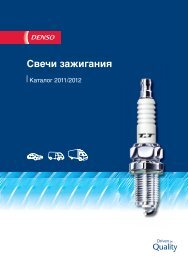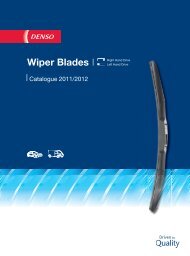A/C Components
A/C Components
A/C Components
You also want an ePaper? Increase the reach of your titles
YUMPU automatically turns print PDFs into web optimized ePapers that Google loves.
GB<br />
System layout<br />
The main purpose of an air conditioning is<br />
to maintain the air in the passenger compartment<br />
at a comfortable temperature by cooling<br />
or heating the air blown into the passenger<br />
compartment. Further it will reduce humidity,<br />
dust and smell in the passenger compartment.<br />
To perform these operations, the air conditioner<br />
for the automobile generally consist of a<br />
heater, cooler (or evaporator), ventilation<br />
system, such as a blower and ducts, and air<br />
purifier.<br />
The 5 main components of a<br />
refrigeration cycle<br />
Compressor (Rotated using a Magnetic<br />
Clutch driven by the Car engine)<br />
Condenser<br />
Receiver / Drier<br />
Expansion Valve<br />
Evaporator<br />
The system components are connected to<br />
each other with different tubes and hoses.<br />
Operation of a car air<br />
conditioning system<br />
a. The Compressor discharges high pressure<br />
and high temperature refrigerant in a gaseous<br />
state. The refrigerant discharged contains<br />
the heat absorbed from the<br />
evaporator and the heat created by the<br />
Compressor in a discharge stroke.<br />
After discharge the refrigerant flows to<br />
the condenser.<br />
b. The condenser will condense the gaseous<br />
refrigerant into a liquid by exchanging heat<br />
with the air passing through the condenser.<br />
When the refrigerant is liquefied it flows to<br />
the Receiver / Drier.<br />
c. The Receiver / Drier will store the refrigerant<br />
until the Evaporator requires it and it will<br />
ensure only liquefied refrigerant flows to the<br />
evaporator. Secondarily the refrigerant is<br />
filtered and dried. After separation of gas<br />
and liquid, liquid refrigerant flows to the<br />
Expansion Valve.<br />
d. The Expansion Valve injects the refrigerant<br />
into the Evaporator changing the<br />
refrigerant from a high pressure and high<br />
temperature liquid into a low pressure and<br />
low temperature liquid and gas mixture.<br />
The refrigerant flows to the Evaporator.<br />
e. The Evaporator vaporises the low pressure<br />
and low temperature refrigerant. When<br />
vaporising the refrigerant a high amount<br />
of heat is required which it will absorb<br />
from the warm air passing through the<br />
evaporator. All liquid will change into a<br />
gaseous refrigerant and only gaseous<br />
refrigerant flows to the Compressor.<br />
The process is then repeated again.<br />
f. The system is controlled using a Computer<br />
or Amplifier in order to maintain a<br />
comfortable interior temperature for driver<br />
and passengers. Sensors are used to protect<br />
the system against too high or too low refrigerant<br />
pressures, frosting of the<br />
evaporator and when necessary to protect<br />
drive belt.<br />
Compressor Condenser Receiver / Dryer<br />
Low pressure<br />
side<br />
High pressure<br />
side<br />
Evaporator Expansion Valve<br />
Cool air Refrigerant flow<br />
Warm air<br />
DENSO EUROPE BV 23<br />
Application A/C System tables LayoutStarters






